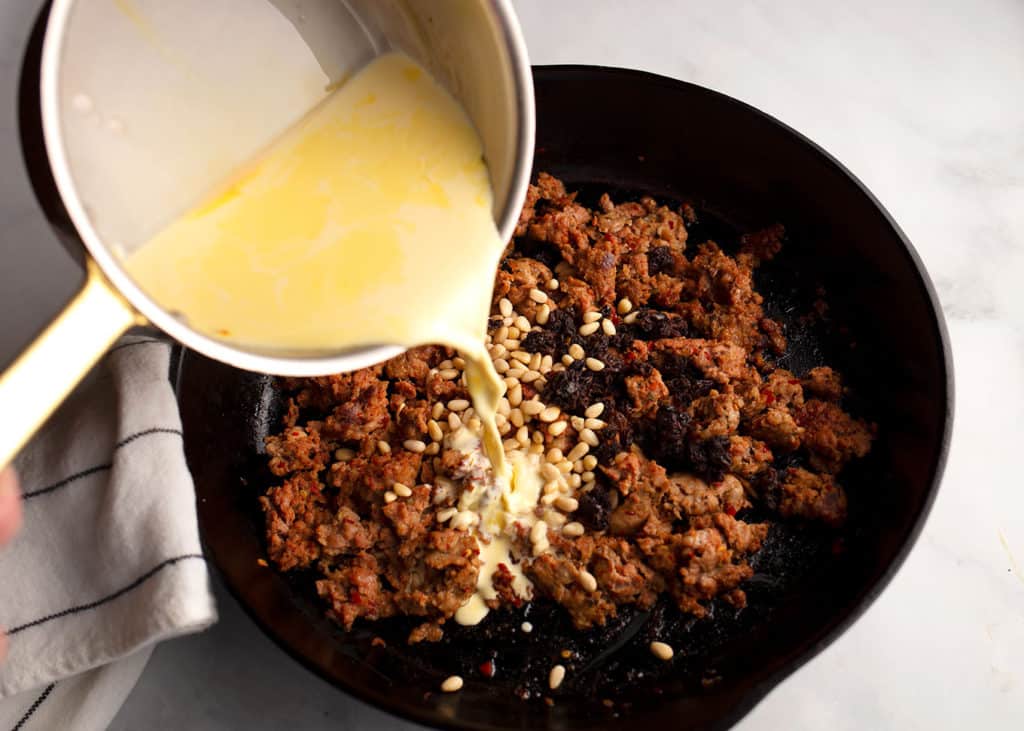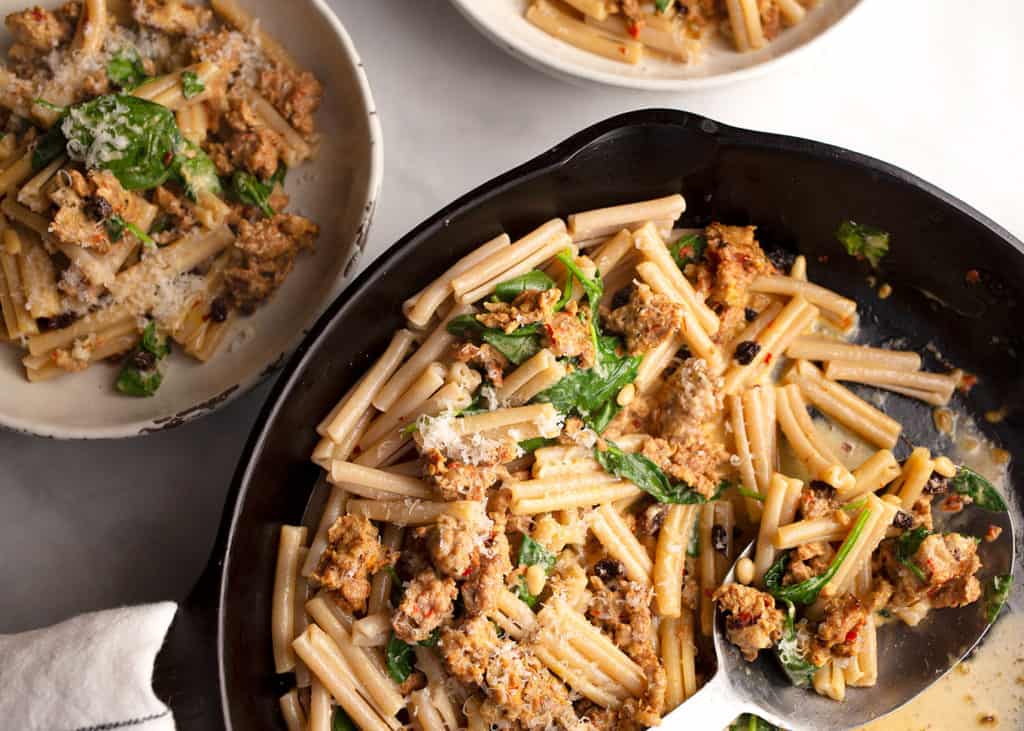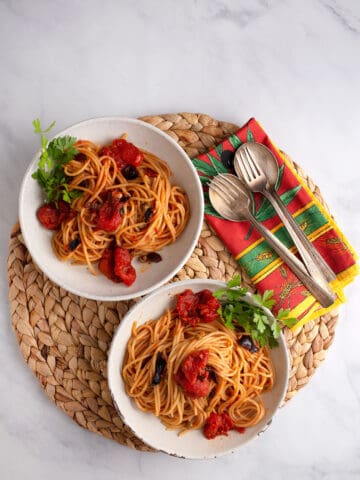There's an Italian restaurant in Seattle that we've been to a few times and absolutely love. The first time we went there was for one of our anniversaries and somehow I ended up with the cookbook that Mauro, owner and head chef, had written. I kind of think that Mauro gave it to us as a gift, but I honestly don't really remember the details. There's a recipe in there for Fusilli Zafferano that calls for using a saffron tea in the sauce. You won't find the recipe on the menu because he made it on a whim for a special guest. So I've been making my version of what I've named Sausage, Pine Nut, & Currant Pasta at home for years. I hope you enjoy it as much as I do!

The recipe really does come together quickly and especially, if you work in a good sequence. I've written the recipe to help you get dinner on quickly!
Saffron tea? Really?!
I know! But hear me out. I'm aware that saffron comes from the crocus and is painstakingly harvested by hand, making it expensive to purchase. The thing is that you rarely use more than a pinch at a time and a small spice bottle of it will last for several dishes. All of that said, I do like the slight indulgence once in a while for the earthy flavor saffron lends to a dish.
Instead of first making a saffron tea, I cut to the chase by steeping the saffron in the cream that will be used for the sauce. You only have to warm the cream ... if you are getting the "skin" on top, turn the flame off right away. You can heat the cream and saffron as much as an hour before and let it just sit. The longer it sits, the more fragrant it becomes.

What kind of pasta should I use to make Sausage, Pine Nut, & Currant Pasta?
I use the Italian brand, Jovial, which is gluten-free and made in the old world style, pressed through bronze presses. I like a shape that will hold the sauce well. Caserecce is really great for this as are fusilli and shells. I've also used plain ol' spaghetti, but this recipe really benefits from pasta with crooks and crevices. In the time that it takes to cook the pasta, you can just about get the sauce made!

What are Zante currants?
Zante currants aren't the currants most of us know that are used in currant jam or to put on top of custard filled tartlets. Currants as we know them come from a flowering bush, but Zante currants are actually grape raisins that come from a vine called Black Corinth grapes. They are originally from Greece and are sweet as you would imagine a raisin to be. Why do these things have to be so confusing!? But I find the information fascinating.
If you simply can't find Zante currants or are unwilling to order them online ... because that is REALLY a thing you can do! ... feel free to substitute raisins (blech!), dried sweetened cranberries (not the same!), or dried cherries (I can't support this decision at all!). But you do you!

A bit about pine nuts
What ARE pine nuts anyway? Are they really nuts?
Well ... glad you asked. Pine nuts, also called piñón, pinoli, or pignoli, actually come from pinyon pine trees. These pines are native to the United States, although pines with edible pine nuts grow in Europe and Asia. They are called "nuts", but they are really seeds in the pine cone. If you have a tree nut allergy, you should be sure you aren't allergic, but it's possible that you could enjoy them symptom free. If you want to be absolutely safe and still want to enjoy this dish without pine nuts, consider substituting sunflower seeds.
Pine nuts are small and fancy. The taste is sweet and subtle and I kind of think they taste like butter! My grandkids think so too and can consume copious amounts of them!
To learn more about PINE NUTS and why they are so expensive, click through to THIS ARTICLE on thespruceeats.com.

Now that we answered all the questions, let's get cooking!
Sausage, Pine Nut, & Currant Pasta calls for spicy sausage and I urge you to not shy away from the spice. It's a beautiful contrast to the saffron cream, currants, and pine nuts. However, if you can't handle the spice, or if you're feeding children, you can choose a mild sausage. You might regret it and I can't guarantee that the dish will have the same delicious effect on you!
Brown the Italian sausage, then add the pine nuts and currants. Reduce the heat, add in the saffron cream, and let it start to thicken slightly.

Look at that beautiful sauce! You can see the yellow from the saffron, the bits of currants and pine nuts ... you'll get a bit of tastiness in every bite.

A final bit to round out the meal is to add some baby spinach. It wilts quickly and adds just a bit more nutrition to the sauce. You could also use arugula or kale. Kale will take longer to soften and might soak up your sauce as it cooks. You can counter that by adding a bit more cream or some pasta water. (I would probably blanch the kale first to soften it ... which is another pot so I'm back to spinach!)

After the spinach wilts a little, put the pasta right in the same skillet. The heat from the pasta will help wilt the spinach, too. Stir it all around and it's ready to put on the table.
How to serve Sausage, Pine Nut, & Currant Pasta
I serve it straight from the skillet, spooning it into handmade pottery pasta plates. My husband insists on eating this with a fork and while I suppose that is probably most common, I prefer a large spoon. With a spoon, I don't have to fight with the pasta and I get the sauce with each bite! Be sure to offer lots of freshly grated Parmiggiano-Reggiano!

Recipe

Sausage, Pine Nut, & Currant Pasta
Ingredients
- 1 cup heavy cream
- 1 pinch saffron threads about ¼ teaspoon
- 1 16-ounce package of casarecce, fusilli, or shells a 12-ounce package is fine as that seems to the be the new norm
- 1 pound spicy Italian sausage Use mild if you prefer.
- 2 Tablespoons pine nuts
- 2 Tablespoons Zante currants See notes
- 2 cup fresh baby spinach leaves
- ⅓ cup pecorino or parmesan cheese
Instructions
- Put the cream in a small saucepan over very low heat. You're just looking to warm it. Add the pinch of saffron threads and allow it to just get warm. Turn the heat off just before a "skin" forms. IF a skin forms, don't panic. Simply pull it to the side of the pan and spoon it out. You can let the saffron cream sit for a bit while you prepare the rest of the dish. You can even make it ahead and refrigerate it. If you do this, bring it back to room temperature before adding it to the recipe.
- In a large saute pan or 12-inch cast iron skillet, brown the Italian sausage. Once it's browned, add the pine nuts and Zante currants. Stir it around so that the pine nuts and currants take on a bit of the sausage flavor.
- Slowly add the saffron cream, all the while stirring. Season with salt and pepper. Allow to thicken just a bit over low to medium heat.
- Add the spinach to the skillet and stir to combine.
- Finally, put the pasta into the skillet. Toss everything to combine.
- Serve immediately with copious amounts of freshly grated parmesan cheese.





Comments
No Comments